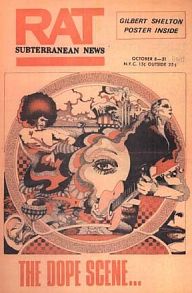
The Weather Underground was a far-left Marxist militant organization first active in 1969, founded on the Ann Arbor campus of the University of Michigan. Originally known as the Weathermen, the group was organized as a faction of Students for a Democratic Society (SDS) national leadership. Officially known as the Weather Underground Organization (WUO) beginning in 1970, the group's express political goal was to create a revolutionary party to overthrow the United States government, which WUO believed to be imperialist.
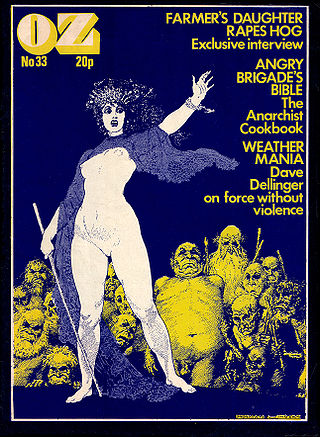
The terms underground press or clandestine press refer to periodicals and publications that are produced without official approval, illegally or against the wishes of a dominant group. In specific recent Asian, American and Western European context, the term "underground press" has most frequently been employed to refer to the independently published and distributed underground papers associated with the counterculture of the late 1960s and early 1970s in India and Bangladesh in Asia, in the United States and Canada in North America, and the United Kingdom and other western nations. It can also refer to the newspapers produced independently in repressive regimes. In German occupied Europe, for example, a thriving underground press operated, usually in association with the Resistance. Other notable examples include the samizdat and bibuła, which operated in the Soviet Union and Poland respectively, during the Cold War.
Liberation News Service (LNS) was a New Left, anti-war underground press news agency that distributed news bulletins and photographs to hundreds of subscribing underground, alternative and radical newspapers from 1967 to 1981. Considered the "Associated Press" for the underground press, at its zenith the LNS served more than 500 papers. Founded in Washington, D.C., it operated out of New York City for most of its existence.
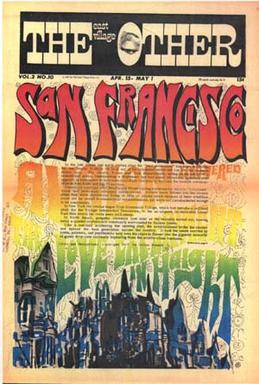
The East Village Other was an American underground newspaper in New York City, issued biweekly during the 1960s. It was described by The New York Times as "a New York newspaper so countercultural that it made The Village Voice look like a church circular".
Steve Clay Wilson was an American underground cartoonist and central figure in the underground comix movement. Wilson attracted attention from readers with aggressively violent and sexually explicit panoramas of lowlife denizens, often depicting the wild escapades of pirates and bikers. He was an early contributor to Zap Comix.
The Underground Press Syndicate (UPS), later known as the Alternative Press Syndicate (APS), was a network of countercultural newspapers and magazines that operated from 1966 into the late 1970s. As it evolved, the Underground Press Syndicate created an Underground Press Service, and later its own magazine.
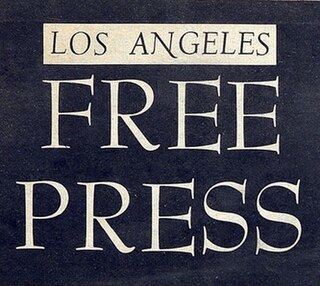
The Los Angeles Free Press, also called the "Freep", is often cited as the first, and certainly was the largest, of the underground newspapers of the 1960s. The Freep was founded in 1964 by Art Kunkin, who served as its publisher until 1971 and continued on as its editor-in-chief through June 1973. The paper closed in 1978. It was unsuccessfully revived a number of times afterward.
Jane Lauren Alpert is an American former far left radical who conspired in the bombings of eight government and commercial office buildings in New York City in 1969. Arrested when other members of her group were caught planting dynamite in National Guard trucks, she pleaded guilty to conspiracy, but a month before her scheduled sentencing jumped bail and went into hiding.

The Chicago Seed was an underground newspaper published biweekly in Chicago, Illinois from May 1967 to 1974; there were 121 issues published in all. It was notable for its colorful psychedelic graphics and its eclectic, non-doctrinaire radical politics. Important events covered by Seed writers and artists were the trial of the Chicago Eight, Woodstock, and the murder of Fred Hampton. At its peak, the Seed circulated between 30,000 and 40,000 copies, with national distribution.

Cell 16, started by Abby Rockefeller, was a progressive feminist organization active in the United States from 1968 to 1973, known for its program of celibacy, separation from men, and self-defense training. The organization had a journal: No More Fun and Games. Considered too extreme by establishment media, the organization was painted as hard left vanguard.
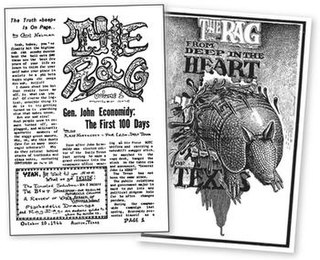
The Rag was an underground newspaper published in Austin, Texas from 1966–1977. The weekly paper covered political and cultural topics that the conventional press ignored, such as the growing antiwar movement, the sexual revolution, gay liberation, and drug culture. It encouraged these political constituencies and countercultural communities to coalesce into a significant political force in Austin. As the sixth member of the Underground Press Syndicate and the first underground paper in the South, The Rag helped shape a flourishing national underground press.

Initially called "The Proud Eagle Tribe," the communiqué from the Women's Brigade of the Weather Underground pledged to "build a militant women's movement that commits itself to the destruction of Amerikan imperialism" and exploit "the man's chauvinism" as a "strategic weakness."
Mother Right was a 10-page manifesto written in 1974 by Jane Alpert, a former Swarthmore College student, radical leftist feminist and associate of the Weather Underground Organization.
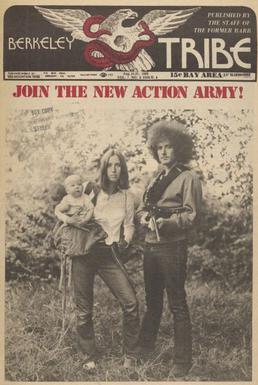
The Berkeley Tribe was a radical counterculture weekly underground newspaper published in Berkeley, California from 1969 to 1972. It was formed after a bitter staff dispute with publisher Max Scherr and split the nationally known Berkeley Barb into new competing underground weeklies. In July 1969 some 40 editorial and production staff with the Barb went on strike for three weeks, then started publishing the Berkeley Tribe as a rival paper, after first printing an interim issue called Barb on Strike to discuss the strike issues with the readership. They incorporated as Red Mountain Tribe, named after Gallo's one gallon finger-ringed jug of cheap wine, Red Mountain. It became a leading publication of the New Left.
The Austin Sun was a biweekly counterculture newspaper that was published in Austin, Texas, between 1974 and 1978.

Old Mole was a radical New Left oriented underground newspaper published in Cambridge, Massachusetts from September 1968 to September 1970. Old Mole was continued by a second volume titled The Mole, which published five issues from November 1970 to April 1971. Printed biweekly in a 16-page tabloid format, Old Mole was based for most of its existence in a storefront and basement office on Brookline Street in Central Square. Selling for 15 cents, 47 issues were published in all, with press runs averaging 8,000–10,000 copies. Subscriptions were free to prisoners and soldiers.
The women's liberation movement was a political movement born in the 1960s from Second-Wave Feminism.

Come Out! was an American LGBT newspaper that ran from 1969 to 1972. It was published by the Gay Liberation Front (GLF), a gay liberation group established in New York City in 1969, immediately following the Stonewall riots. The first issue came out on November 14, 1969, it sold for 35 cents, and 50 cents for outside of New York City. Its run only lasted for eight issues. Its tagline for the first paper was: "A Newspaper By And For The Gay Community".

Earth magazine was a counterculture magazine published in the 1970s. It later became Earth News, an alternative news agency for radio stations. Former staffers from Earth later formed a number of alternative news agencies of their own, all of which survived into the 1980s.
